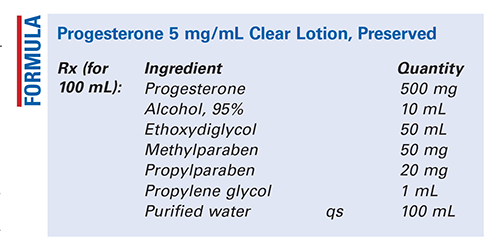US Pharm. 2022;47(9):58-59.

Method of Preparation: Calculate the required quantity of each ingredient for the total amount to be prepared. Accurately weigh/measure each ingredient. Dissolve the progesterone in the alcohol. Add the ethoxy diglycol; mix well. Dissolve the methyl paraben and propylparaben in the propylene glycol; add to the progesterone solution and mix well. Slowly and with stirring, add sufficient purified water to final volume; mix well. Package and label.
Use: This solution has been used to treat seborrhea in women.
Packaging: Package in tight, light-resistant containers.
Labeling: Keep out of reach of children. Discard after ____ [time period].
Stability: A beyond-use date of 30 days may be used for this preparation.1
Quality Control: Quality-control assessment can include weight/volume, pH, specific gravity, active drug assay, color, clarity, physical observation, physical stability (discoloration, foreign materials, gas formation, mold growth), and preservative-effectiveness test.2,3
Discussion: Also called antiseborrhea clear solution, this preparation has been used in women whose seborrhea is responsive to progesterone.
Progesterone is a naturally occurring progestin that occurs as a white or creamy white, crystalline powder that is practically insoluble in water, soluble in alcohol, and sparingly soluble in vegetable oils.1,2,4
Alcohol, 95% (ethyl alcohol, ethanol, grain alcohol, C2H5OH, MW 46.07) is a clear, colorless, mobile, volatile liquid with a slight, characteristic odor and a burning taste. Alcohol USP refers to 95% ethanol, and dehydrated alcohol refers to 99.5% alcohol. Its specific gravity is between 0.812 and 0.816, and its boiling point is 78.15°C. Alcohol is miscible with chloroform, glycerin, and water.1,5
Ethoxydiglycol (CH2OHCH2OCH2CH2OC2H5, C6H14O3, MW 134.20) is also known as diethylene glycol monoethyl ether, diethylene glycol ethyl ether, Carbitol, and Transcutol. It occurs as a colorless liquid with a mild pleasant odor and has a density of 1.0272. Ethoxydiglycol is hygroscopic, and it is miscible with water and with common organic solvents. It is nonirritating and nonpenetrating when applied to human skin, and it is used as a solvent, solubilizer, and cosurfactant.1,6,7
Methylparaben (methyl hydroxybenzoate, methyl parahydroxybenzoate, C8H8O3) is available as colorless crystals or as a white, crystalline powder that is odorless or almost odorless and has a slight burning taste. It is an antimicrobial preservative. Methylparaben is most effective in solutions of pH 4 to 8, and its efficacy decreases at higher pH levels. One gram is soluble in 400 mL water, 3 mL 95% ethanol, 60 mL glycerin, 200 mL peanut oil, and 5 mL propylene glycol (PG), and it is practically insoluble in mineral oil.8
Propylparaben (propyl hydroxybenzoate, propyl parahydroxybenzoate, C10H12O3) is available as a white, crystalline, odorless, and tasteless powder. It is an antimicrobial. One gram is soluble in 2,500 mL water, 1.1 mL ethanol, 250 mL glycerin, 3,330 mL mineral oil, 70 mL peanut oil, and 3.9 mL PG.9
PG (C3H8O2) occurs as a clear, colorless, viscous, practically odorless liquid with a sweet taste, somewhat resembling glycerin. It is miscible with acetone, chloroform, 95% ethanol, glycerin, and water. Since PG is hygroscopic, it should be stored in an airtight container and protected from light.10
The content contained in this article is for informational purposes only. The content is not intended to be a substitute for professional advice. Reliance on any information provided in this article is solely at your own risk.
To comment on this article, contact rdavidson@uspharmacist.com.





